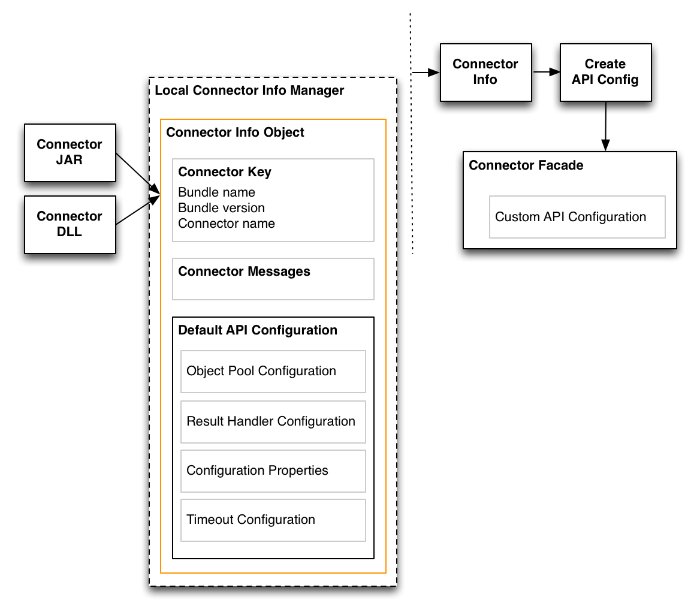About the Connector Facade
Important
Connectors continue to be released outside the IDM release. For the latest documentation, refer to the ICF documentation.
An application interacts with a connector through an instance of the ConnectorFacade class. The following diagram shows the creation and configuration of the connector facade. The components shown here are described in more detail in the sections that follow.
The connector facade is instantiated and configured in the following steps:
The application creates a
LocalConnectorInfoManagerinstance (or instances) and adds the individual connector bundles (or assemblies).The
LocalConnectorInfoManagerprocesses these bundles or assemblies to instantiate aConnectorInfoobject.To be processed by the connector info manager, the connector bundle or assembly must have the following characteristics:
- Java Connector Bundle
The
META-INF/MANIFEST.MFfile must include the following entries:ConnectorBundle-FrameworkVersion- Minimum required ICF Framework version (either 1.1, 1.4, or 1.5)ConnectorBundle-Name- Unique name of the connector bundleConnectorBundle-Version- Version of the connector bundleThe combination of the
ConnectorBundle-Nameand theConnectorBundle-Versionmust be unique.The connector bundle JAR must contain at least one class, that has the
ConnectorClassannotation and implements theConnectorinterface.- .NET Connector Assembly
The
AssemblyInfo.csis used to determine the bundle version, from theAssemblyVersionproperty.The bundle name is derived from the
Nameproperty of the assembly. For more information, see the corresponding Microsoft documentation.Warning
If you change the name of your assembly, you must adjust the
bundleNameproperty in your connector configuration file, accordingly.The connector assembly DLL must contain at least one class, that has the
ConnectorClassAttributeattribute and implements theConnectorinterface.
For each connector, the
LocalConnectorInfoManagerprocesses theMessageCatalog, which contains the localized help and description messages for the configuration, and any log or error messages for the connector.Your application can use this information to provide additional help during the connector configuration process.
For each connector, the
LocalConnectorInfoManagerthen processes theConfigurationClass, to build the configuration properties for the connector.Your application finds the connector info by its connector key. When the application has the connector info, it creates an API Configuration object that customises the following components:
Object pool configuration
Result handler configuration
Configuration properties
Timeout configuration
The API Configuration object is described in more detail in "The API Configuration Object".
The
ConnectorFacadetakes this customized API configuration object, determines which connector to use and how to configure it, and implements all of the ICF API operations.
